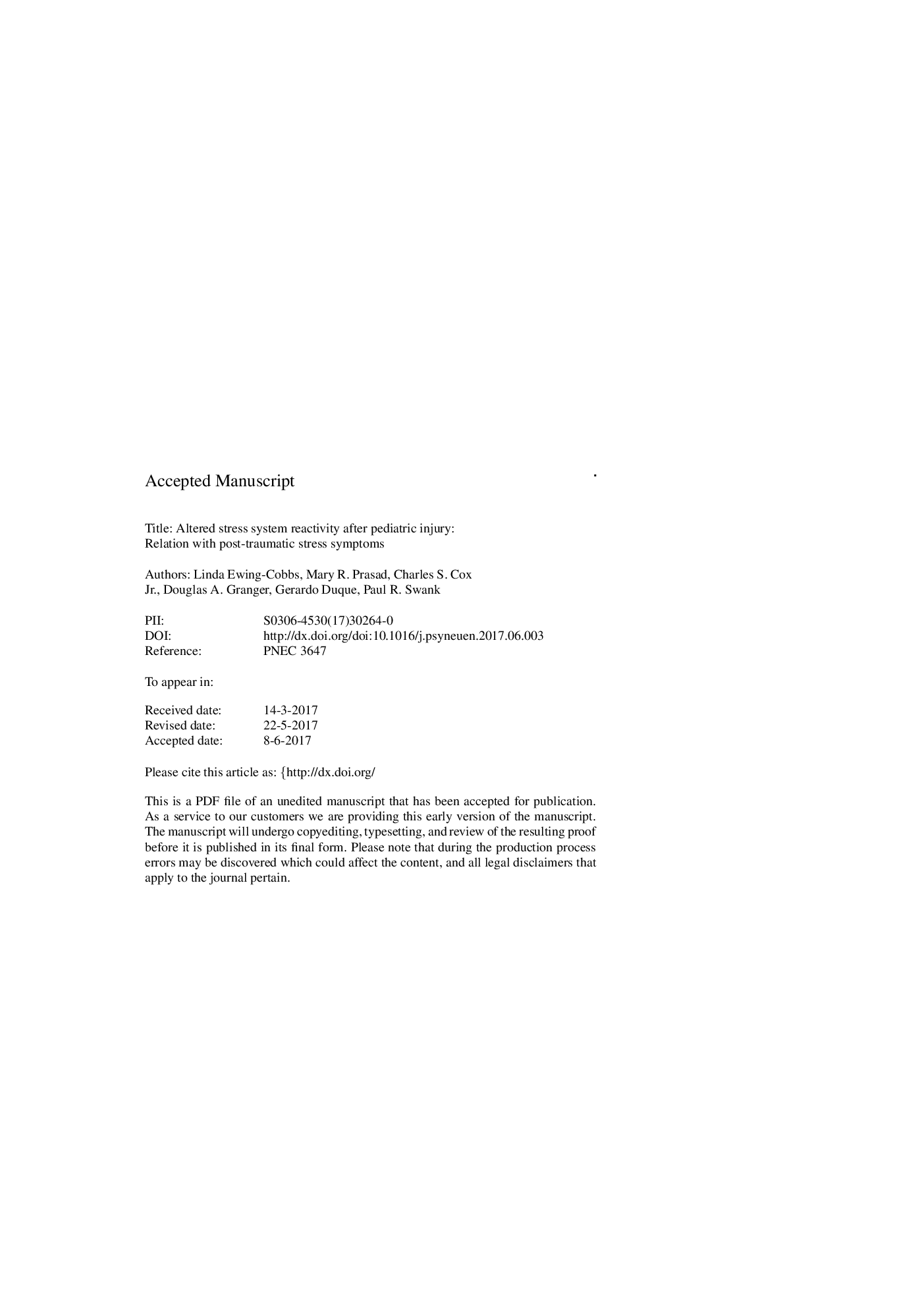| کد مقاله | کد نشریه | سال انتشار | مقاله انگلیسی | نسخه تمام متن |
|---|---|---|---|---|
| 4934205 | 1433959 | 2017 | 38 صفحه PDF | دانلود رایگان |
عنوان انگلیسی مقاله ISI
Altered stress system reactivity after pediatric injury: Relation with post-traumatic stress symptoms
ترجمه فارسی عنوان
واکنش پذیری سیستم تغییر یافته پس از آسیب اطفال: ارتباط با علائم استرس پس از ضربه
دانلود مقاله + سفارش ترجمه
دانلود مقاله ISI انگلیسی
رایگان برای ایرانیان
کلمات کلیدی
غده هیپوفیز هیپوتالاموس، سامانه ی عصبی خودمختار، کورتیزول، آلفا آمیلاز بزاق، صدمه، استرس پس از سانحه،
موضوعات مرتبط
علوم زیستی و بیوفناوری
بیوشیمی، ژنتیک و زیست شناسی مولکولی
علوم غدد
چکیده انگلیسی
Injury is the leading cause of death and disability in childhood. Injured children are at high risk for developing alterations in stress response systems and post-traumatic stress symptoms (PTSS) that may compromise long-term physical and psychological health. In a prospective, observational cohort study, we examined individual differences in, and correlates of, stress-reactivity of the hypothalamic-pituitary-adrenal axis (HPA; salivary cortisol) and autonomic nervous system (ANS; salivary alpha amylase, sAA) following pediatric injury. Participants were 8-15 years of age and hospitalized for traumatic brain injury (TBI; n = 55; M age = 13.9 yrs; 40 males) or extracranial injury (EI; n = 29; M age 12.3 yrs, 20 males) following vehicular accidents. Six months post-injury, saliva was collected before and after the Trier Social Stress Test and later assayed for cortisol and sAA. Relative to a healthy non-injured comparison group (n = 33; M age = 12.5 yrs, 16 males), injured children (ages 8-12 years), but not adolescents (ages 13-15 yrs), had higher cortisol levels; regardless of age, injured participants showed dampened cortisol reactivity to social evaluative threat. Compared to participants with EI, children with TBI had elevated cortisol and adolescents had elevated sAA. With respect to PTSS, individual differences in sAA were negatively correlated with avoidance in the TBI group and positively correlated with emotional numbing within the EI group. Importantly, psychological and neurobiological sequelae were weakly related to injury severity. Given the high prevalence of pediatric injury, these sequelae affect many children and represent a significant public health concern. Consequently, surveillance of post-traumatic sequelae should include the full spectrum of injury severity. Monitoring the activity, reactivity, and regulation of biological systems sensitive to environmental insults may advance our understanding of individual differences in sequelae and adaptation following traumatic pediatric injury.
ناشر
Database: Elsevier - ScienceDirect (ساینس دایرکت)
Journal: Psychoneuroendocrinology - Volume 84, October 2017, Pages 66-75
Journal: Psychoneuroendocrinology - Volume 84, October 2017, Pages 66-75
نویسندگان
Linda Ewing-Cobbs, Mary R. Prasad, Charles S. Jr., Douglas A. Granger, Gerardo Duque, Paul R. Swank,
